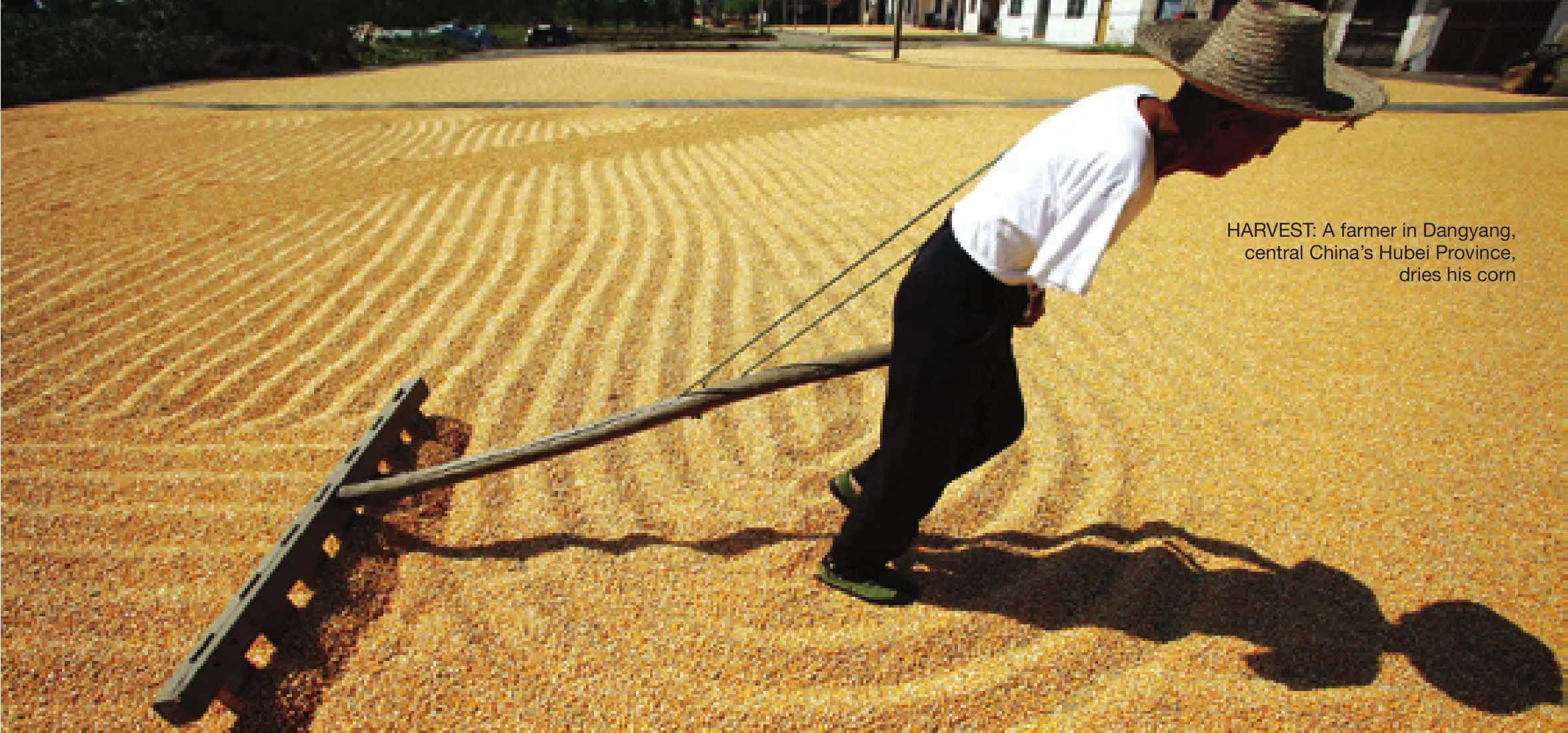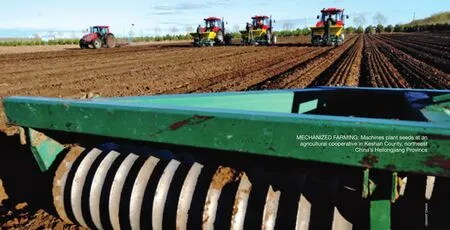Making the Modern Farm
2012-10-16ChangesininnovationandinvestmentareneededtogetChinaagriculturalsectoroutofthestoneageByLanXinzhen
Changes in innovation and investment are needed to get China’s agricultural sector out of the stone age By Lan Xinzhen
Making the Modern Farm
Changes in innovation and investment are needed to get China’s agricultural sector out of the stone age By Lan Xinzhen
Seventy-two-year old Eleanor Dvorchak is a typical American farmer with an incredible tie to China: he has twice hosted Chinese Vice President Xi Jinping in his home in Muscatine, Iowa.
Xi fi rst visited Muscatine in 1985 as a provincial official from Iowa’s sister province of Hebei. Leading a delegation of four other local of fi cials on an educational trip primarily focused on agriculture, Xi and his colleagues toured local farms and businesses as part of an exchange.
During that tour, Xi spent two nights with the Dvorchaks, who put Xi up in their son’s bed.
During the trip, Xi was amazed with America’s hi-tech, modern agricultural industry.In China, rural areas were still being farmed by primitive tools like ploughs and sickles.
Today Chinese agriculture has evolved from those simple tools of the past. Major grain-producing areas have realized agricultural mechanization, with technology increasing by leaps and bounds. Better seeds are used to help the country produce more to feed its vast population. Last year, China saw a bumper harvest of grain, with its output rising to a record high of 571.21 million tons,a year-on-year increase of 4.5 percent. The strong harvest marked eight consecutive years of growth for China’s grain output.
Even so, China has to face the fact that its agricultural sector falls far short of the United States in several fi elds.
According to a report released by the China Center for Modernization Research of the Chinese Academy of Sciences on May 13,China’s agricultural level is about 100 years behind that of the United States.
He Chuanqi, Director of the China Center for Modernization Research, said that as the world biggest agricultural country, China fi nds the agricultural sector a drag on the development of its modernization.
Today, improving the rural economy is an important issue China has to deal with.
Why the lag?
The report concludes that despite its high yield of staple grains, China is still hindered by low labor productivity. In 2008, the country’s agricultural labor productivity was only 47 percent of the world’s average and ranked 91st worldwide.
China’s current agricultural labor productivity is around 1 percent of that in the United States, Japan and France, and is even lower than that of Brazil, another emerging country.
The low level may come as a shock, but He is not surprised.
According to He, agricultural modernization usually comprises two phases, with the fi rst characterized by marketization, industrialization and mechanization, and the second by informationization, ecologicalization, diversi fi cation and internationalization.
China ranks 75th worldwide in terms of phase one of agricultural modernization, 62nd of phase two of agricultural modernization,and 65th in terms of the comprehensive level,according to the report.
According to He, since China’s population is expected to expand to about 1.5 billion by 2050,its demand for grain and meat will increase to 780 million tons and 120 million tons, respectively. In the fi rst half of this century, another 300 million tons of grain and 50 million tons of meat will be needed to feed the entire population. At the same time, a decrease in per-capita arable land will reduce China’s agricultural capability.
“Meeting the increasing demand for agricultural produce is both a big opportunity and a challenge for China’s agriculture sector,”said He.
Different views
Is China’s agriculture really that backward?So far, expert opinions vary.
It is not proper to compare two countries’ agricultural level simply via statistics,said Huang Jikun, Director of the Center for Chinese Agricultural Policy.

WENZ ZhENXiAo

“Different countries have different agricultural resources and national conditions. It does not make sense to use agricultural labor productivity to appraise the agricultural modernization level,” said Huang.
According to Huang, the comparable indicator for agricultural modernization should be the technology level, per-unit output of grain and total factor productivity. The comparison of agricultural modernization between different countries should focus on production costs and prices.
“China is behind the United States in this aspect, but the distance is not that large. It is greatly exaggerated by saying that the agricultural sophistication level of China is more than 100 years behind that of Western countries,” said Huang.
According to Zhang Hongyu, Director of the Policy and Law Department of the Chinese Ministry of Agriculture, the goal of China’s agricultural modernization is to transform traditional agriculture, reach the world advanced level in some aspects and approach the level of advanced countries.
Zhang said Chinese agriculture has made progress, and disagreed with He.
“In recent years, China has reached the level of advanced countries in terms of the yields of rice and wheat, as well as the level of newly developed countries in terms of 26 indicators, including agricultural mechanization and nutrient supply per capita,” said Zhang.
According to Zhang, it is objective to say that Chinese agriculture is in good shape in spite of various dif fi culties and that its overall productivity is still low and farmers’ incomes need to be increased rapidly.
Searching for solutions
The first National Modern Agriculture Development Plan issued in February this year is a programmatic document for the development of modern Chinese agriculture. It presents a blueprint for modern agricultural development for the whole century.
By 2050, the country is expected to have a moderately-developed agricultural industry and by 2100 an advanced one.
But low agricultural production ef fi ciency could be the biggest obstacle hindering China’s agricultural modernization.
How to improve agricultural labor productivity? Director He offered five suggestions, namely, deepening the reform of agricultural scientific and technological systems, deepening the reform of rural fi nancial systems, advancing the reform of water conservancy, promoting the reform of rural land systems and implementing a high-quality grain project.
Breakthroughs in these reforms will help increase China’s agricultural production effi ciency substantially, said the report.
But He pointed out certain pitfalls could slow this much sought after progress. Take the rural fi nancial system for example. Unmet demand for rural credit is huge. It is hard for Chinese farmers to get micro-loans to buy production materials. In addition, rural cooperative insurance for natural disasters is urgently needed, but no insurers are willing to provide this kind of insurance, even state-own ones.
He also suggested the government implement training programs for farmers to improve their farming techniques. While American farmers are sur fi ng on the Internet for market information and agricultural technology, most Chinese farmers even don’t know how to use computers.
“We need to train new farmers who can meet the need of marketization, industrialization, informationization, ecologicalization and globalization,” said He.
According to He Xiurong, a researcher of the agricultural economy and policy with the China University of Agriculture, reforming the agricultural system and associated mechanics is the fundamental factor to agricultural modernization.
